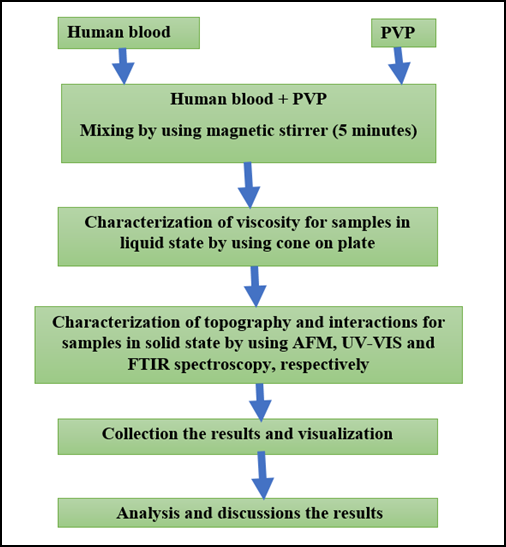
Physical and Chemical Characterization of Drag Reducing Polymer Based on Polyvinylpyrrolidone (PVP) in Human Blood Flow
Abstract
Keywords
Full Text:
PDFReferences
Marhefka JN, Kameneva MV. Natural drag-reducing polymers: Discovery, characterization and potential clinical applications. Fluids. 2016;1(2):6. doi:10.3390/fluids1020006
Holzner M. Polymers Reduce Drag More than Expected. Physics. 2018;11:29. doi:10.1103/Physics.11.29
Gannushkina IV, Grigoryan SS, Kameneva MV, Shakhnazarov AA. The possibility that after circulatory ischemia of the brain the blood circulation can be restored by introducing special polymers into the blood. Soviet Physics Doklady. 1981;26:376.
Kameneva MV. Microrheological effects of drag-reducing polymers in vitro and in vivo. International Journal of Engineering Science. 2012 Oct 1;59:168-83. doi:10.1016/j.ijengsci.2012.03.014
Kameneva MV, Wu ZJ, Uraysh A, Repko B, Litwak KN, Billiar TR, Fink MP, Simmons RL, Griffith BP, Borovetz HS. Blood soluble drag‐reducing polymers prevent lethality from hemorrhagic shock in acute animal experiments. Biorheology. 2004;41(1):53-64.
Yousif Z. Drag reduction study of xathan gum with polydiallyldimethylammonium chloride (PDDAC) solutions in turbulent flow. Engineering and Technology Journal. 2018;36:891-9. doi:10.30684/etj.336.8A.8
Golub AS, Grigoryan SS, Kameneva MV, Malkina NA, Shoshenko KA. Influence of polyethylene oxide on the capillary blood flow in diabetic rats. Soviet Physics Doklady. 1987;32:620.
Polimeni PI, Ottenbreit BT. Hemodynamic effects of a poly (ethylene oxide) drag-reducing polymer, Polyox WSR N-60K, in the open-chest rat. J Cardiovasc Pharmacol. 1989;14(3):374-80. doi:10.1097/00005344-198909000-00004
Braihi AJ, Rashid FL, Jawad AJ. Investigation of flow behavior characteristics for Iraqi crude oil with different polymeric additives. J Mech Eng Res Dev. 2020;43(4):41-9.
Grigoryan SS, Kameneva MV, Shakhnazarov AA. Effect of high molecular weight compounds dissolved in blood on hemodynamics. Soviet Physics Doklady. 1976;21:702.
Gannushkina IV, Antelava AL, Baranchikova MV. Suppression of experimental alimentary atherosclerosis with drag reducing polymers. Bulletin of experimental biology and medicine. 1993 Oct;116(4):1219-22. doi:10.1007/BF00802836
Mostardi RA, Greene HL, Nokes RF, Thomas LC, Lue T. The effect of drag reducing agents on stenotic flow disturbances in dogs. Biorheology. 1976;13(2):137-41. doi:10.3233/bir-1976-13208
Faruqui FI, Otten MD, Polimeni PI. Protection against atherogenesis with the polymer drag-reducing agent Separan AP-30. Circulation. 1987;75(3):627-35. doi:10.1161/01.CIR.75.3.627
Fischer F, Bauer S. Polyvinylpyrrolidon. Ein tausendsassa in der chemie. Chemie in unserer Zeit. 2009;43(6):376-83. German. doi:10.1002/ciuz.200900492
Rashid FL, Braihi AJ, Hashim A, Jawad AJ. Drag Reduction of Iraqi Crude Oil Flow in Pipelines by Polymeric Additives. International Journal of Mechanical Engineering and Technology. 2018;9(13):1049-60.
Jawad AJ, Jassim AE, Hadi NJ. Flow behavior of poly (vinyl alcohol)/aluminum oxide nanoparticles solutions as novel method to control the viscosity. Pakistan Journal of Medical & Health Sciences. 2020;14(4):1550-8.
Jawad AJ, Jassim AE, Hadi NJ. Effect of titanium dioxide nanoparticles (TiO2 NPs) on rheological characteristics behavior of poly vinyl acetate (PVAc). NanoWorld Journal. 2020;6(3):61-5. doi:10.17756/nwj.2020-080
Boyle BM, Heinz O, Miyake GM, Ding Y. Impact of the pendant group on the chain conformation and bulk properties of norbornene imide-based polymers. Macromolecules. 2019 Apr 29;52(9):3426-34. doi:10.1021/acs.macromol.9b00020
Pribush A, Hatzkelzon L, Meyerstein D, Meyerstein N. The mechanism of the polymer-induced drag reduction in blood. Colloids and Surfaces B: Biointerfaces. 2013 Mar 1;103:354-9. doi:10.1016/j.colsurfb.2012.11.004
Marhefka JN, Zhao R, Wu ZJ, Velankar SS, Antaki JF, Kameneva MV. Drag reducing polymers improve tissue perfusion via modification of the RBC traffic in microvessels. Biorheology. 2009;46(4):281-92. doi:10.3233/BIR-2009-0543
Ushasree UV, Jaleeli KA, Ahmad A. Study on infrared spectroscopy of human blood. Int J Sci Environ Technol. 2006;5:1189-92.
Aziz SB, Brza MA, Nofal MM, Abdulwahid RT, Hussen SA, Hussein AM, Karim WO. A comprehensive review on optical properties of polymer electrolytes and composites. Materials. 2020;13(17):3675. doi:10.3390/ma13173675
DOI: https://doi.org/10.15826/chimtech.2021.8.2.07
Copyright (c) 2021 Akram Jawad, Auda Braihi

This work is licensed under a Creative Commons Attribution 4.0 International License.
Chimica Techno Acta, 2014–2025
eISSN 2411-1414
Copyright Notice







